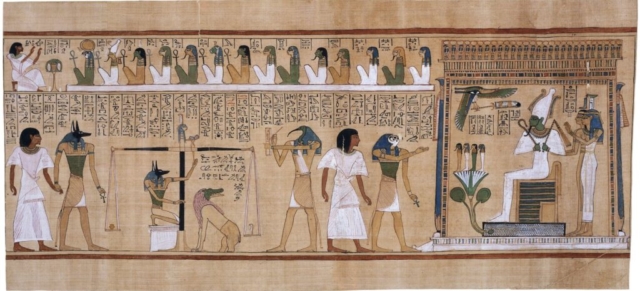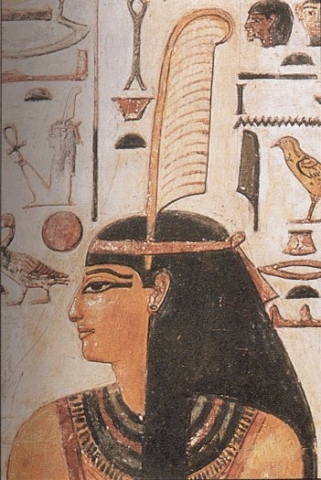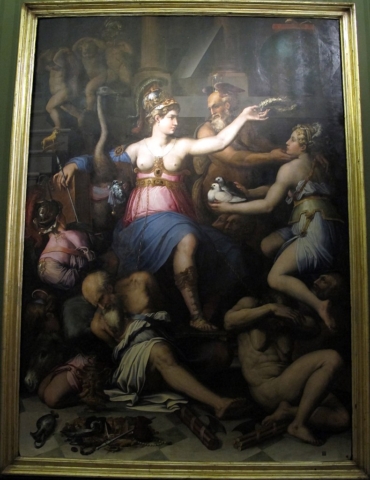Egyptians were the first to symbolically associate the ostrich with justice. Maat, the goddess of justice, is usually depicted wearing an ostrich feather. The image above shows a scene from the Book of the Dead that depicts the “Weighting of the heart” ritual. In the “Weighting of the heart’ ritual, the heart of of the deceased is weighted against the feather of Maat or the feather of truth.
The tradition of associating the ostrich with justice continued until the Baroque era. Later I will show a few relevant paintings, but first I will try to explain the reason behind this strange symbolic association.
Explanation
I believe that the best explanation is given by Horapollo in his book Hieroglyphica. In chapter 158 “CXVIII. HOW A MAN WHO DISTRIBUTES JUSTICE IMPARTIALLY TO ALL” it says [1]:
When they would symbolise a man who distributes justice impartially to all, they depict THE FEATHER OF AN OSTRICH; for this bird has the feathers of its wings equal on every side, beyond all other birds.
Hieroglyphics of Horapollo
So the symbolic association between the ostrich feather and justice is due to the symmetry of the feather. The visual symmetrical balance of the feather was extended by Egyptians to the feather actually balancing the heart of the deceased on a scale. The heart of a just person is in balance with the feather of Maat. However, the heart of an unjust man is heavier than the feather.
The Pierce Tempest edition of Iconologia (1709) gives the following description of Justice [2]:
A Virgin all in white; blinded; in her right hand she holds the Roman Fasces, with an ax in it; in her left, a flame, and an Ostrich by her side;
The White shews that she should be spotless, void of Passion, without Respect for Persons, as she, being hoodwinked, declares. The Fasces denote Whipping for small offences, and cutting off the head for Hainous ones. The Ostrich , that Things should be ruminated upon, how hard soever they be, as the Ostrich, in time, digests hard iron.
Iconologia (Pierce Tempest 109 edition)
The belief that the stomach of an ostrich can digest even iron can also be found in “Pseudodoxia Epidemica” by Thomas Browne (1646). The ability of the ostrich to digest iron is a metaphor for Justice “ruminating” or “thinking deeply”. Justice is imparted only after carefully considering or “digesting” the relevant evidence to the case at hand.
The topic of “rumination” in Iconologia is also mentioned when discussing Prudence. But Prudence’s “rumination” is allegorical represented by the stag, instead of the ostrich (also see Luca Giordano’s Allegory of Prudence) . The parallels between the allegorical descriptions of Justice and Prudence point out the fact that both require a careful deliberation of things.
Visual Representations
Since it was the Egyptians who started the tradition of associating the ostrich with justice,, it is worth seeing a more detailed image of Maat. The image below shows a detailed depiction of Maat with the Feather of Truth.
The depiction of Justice found in the Pierce Tempest edition of Iconologia is a bit rudimentary, however it is important to point out that not all editions of Iconologia depict Justice with an ostrich. The description and depiction of allegorical images vary from edition to edition.
The image below shows Giorgio Vasari’s “Allegory of Justice” (1543). The painting contains many allegorical figures and elements, besides Justice and the ostrich.
The best allegorical painting of Justice that contains an ostrich is probably Luca Giordano’s Allegory of Justice. You can see the painting on the National Gallery of Art (UK) website. Like Vasari’s painting, Giordano’s painting also contains many allegorical figures that make the painting very complex. Many of the allegorical figures are probably also inspired from an edition of Iconologia.



